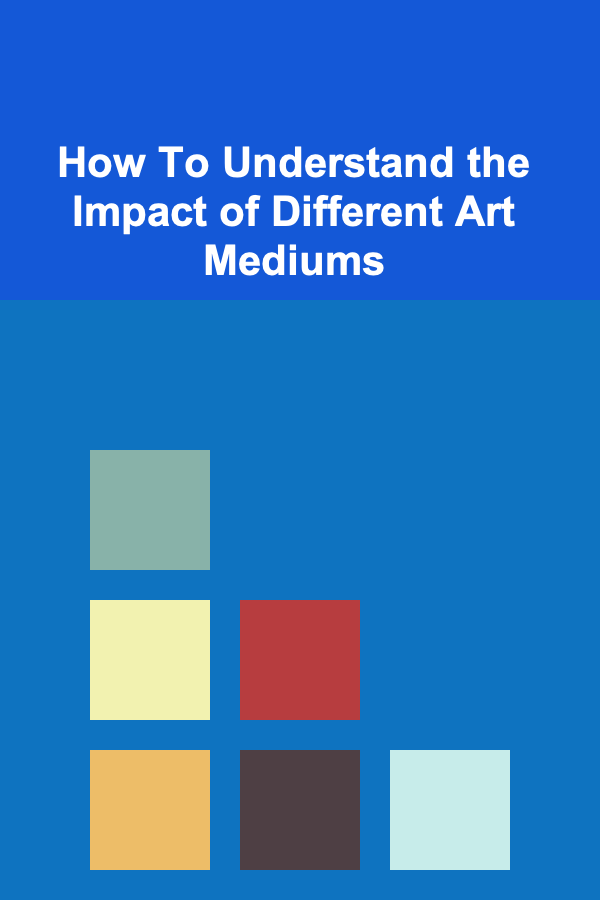
How To Understand the Impact of Different Art Mediums
ebook include PDF & Audio bundle (Micro Guide)
$12.99$5.99
Limited Time Offer! Order within the next:

Art, in all its diverse forms, holds a unique power to evoke emotion, provoke thought, and inspire change. Over centuries, the mediums through which art is created have evolved, shifting the way we interpret and experience it. From ancient cave paintings to digital installations, art mediums are more than mere tools for expression; they shape the messages conveyed, the emotions stirred, and the cultural narratives formed. Understanding the impact of different art mediums requires more than just an appreciation of aesthetics; it necessitates a deeper exploration into how each medium interacts with the viewer and shapes the world around us.
In this article, we will explore the impact of various art mediums, ranging from traditional forms like painting and sculpture to newer mediums such as digital art and performance. We will analyze how these mediums influence the way art is perceived and understood and discuss their role in shaping cultural and social realities.
The Role of Traditional Art Mediums
Painting
Painting, one of the oldest and most established art forms, remains a cornerstone in understanding the human experience. Its impact can be traced back to prehistoric times, with cave paintings offering the earliest glimpse into human creativity and communication. The medium has since evolved into an incredibly diverse range of styles, from the realism of the Renaissance to the abstract expressions of modernism.
Impact on Perception and Emotion:
Painting has a profound ability to manipulate color, texture, and form to evoke specific emotional responses. The use of light and shadow in works like Caravaggio's religious scenes draws the viewer into an emotional confrontation with the subject matter, while the soft pastel hues in Monet's impressionistic works invite reflection and tranquility. A painting's ability to affect mood is often connected to its medium -- oil paints allow for rich detail and depth, while watercolor offers a lightness and fluidity that evokes gentler feelings.
Cultural Influence:
Throughout history, painting has played a significant role in documenting and reflecting society. Think of the political messages in Goya's "The Third of May 1808" or the social commentary in Picasso's "Guernica." These works, produced in response to historical events, illustrate how the medium of painting can document trauma, societal upheaval, and human resilience. The content and themes portrayed through paintings provide insights into the values and struggles of the time, shaping our understanding of cultural identity and collective memory.
Sculpture
Sculpture, with its three-dimensional form, has a different relationship with the viewer than painting. It exists in space and can be interacted with physically, offering a tactile dimension to the viewer's experience. From ancient Greek statues that idealize human form to modern, abstract sculptures, the medium has continued to challenge our perception of space, form, and material.
Impact on Perception and Emotion:
Sculpture's physical presence and scale can create a direct, visceral impact on the viewer. A large, imposing statue such as Michelangelo's "David" commands awe and reverence, while smaller works like Henry Moore's abstract pieces can invite personal, intimate contemplation. The material of a sculpture---whether it is marble, bronze, or clay---also plays a role in shaping the emotional response. Stone evokes permanence, while softer materials like clay can suggest malleability and change.
Cultural Influence:
Throughout history, sculptures have not only served as symbols of power (as seen in monuments and statues of rulers) but also as representations of philosophical ideals, religious beliefs, and the human condition. The very act of creating a statue for public display is an assertion of significance, whether through religious iconography, civic pride, or individual expression. As such, sculptures have long been instruments in shaping cultural and societal identities.
The Evolution of Art in Modern Mediums
Photography
Photography, which emerged in the 19th century, is often thought of as the medium that captures reality. While painting and sculpture can be subjective, photography is typically regarded as a documentary tool, offering a direct snapshot of the world. However, as the medium has evolved, photography has transcended mere representation and become a powerful tool for artistic expression.
Impact on Perception and Emotion:
Photography can freeze a moment in time, preserving fleeting expressions, gestures, and events that would otherwise be lost to history. The emotional impact of a photograph often comes from its ability to capture real-life moments, whether they are joyful, tragic, or mundane. The work of photojournalists like Dorothea Lange in the Great Depression or modern photographers like Steve McCurry with "Afghan Girl" demonstrates how photography can expose social conditions, create empathy, and provoke action.
Cultural Influence:
Photography's documentary nature has revolutionized our understanding of history, politics, and social issues. From the Civil Rights Movement to the wars of the 20th and 21st centuries, photographs have borne witness to moments of social change, offering a visual record of injustice, suffering, and triumph. In this way, photography acts as both an art form and a historical document, shaping collective memory and influencing societal attitudes toward key events.
Film and Video
Film and video are perhaps the most impactful contemporary art mediums, combining visual aesthetics with sound and narrative. The cinematic arts have expanded the language of storytelling, bringing art into the realm of entertainment, education, and activism.
Impact on Perception and Emotion:
The combination of moving images, sound, and narrative structure in film allows for complex emotional engagement. Films can immerse viewers in worlds that range from realistic to fantastical, affecting their emotions in deep and multifaceted ways. Directors like Alfred Hitchcock or Ingmar Bergman have explored the psychological depth of their characters, while filmmakers like Hayao Miyazaki have created entire worlds that stir the imagination and foster empathy.
Cultural Influence:
Film has the power to shape global culture like no other medium. Hollywood has long been seen as the dominant force in global cinema, but regional film industries---such as Bollywood, Nollywood, or the French New Wave---also produce influential works that reflect the values, struggles, and aspirations of their respective societies. Moreover, films are capable of addressing pressing social issues, as seen in works like "12 Years a Slave" or "Parasite," both of which tackle themes of race, inequality, and social mobility.
Digital Art
In the last few decades, digital art has emerged as a dominant force in the contemporary art world. Digital tools have given artists the ability to manipulate and create new forms of art that could not have been achieved through traditional mediums.
Impact on Perception and Emotion:
Digital art introduces a new layer of interactivity and immediacy. Whether through virtual reality (VR), augmented reality (AR), or interactive installations, digital art often requires the viewer to engage with the piece in new ways. This interactivity can alter the emotional experience, as the viewer becomes an active participant in the artwork rather than a passive observer. The ever-changing nature of digital art also challenges traditional concepts of permanence, inviting the viewer to reconsider the notion of what it means for art to "exist."
Cultural Influence:
Digital art reflects the rapid technological advancements and cultural shifts of the 21st century. As technology increasingly mediates our daily lives, digital art raises questions about identity, communication, and the intersection of the physical and virtual worlds. Digital art also democratizes the production and dissemination of artwork, allowing artists to reach global audiences and collaborate in ways previously unimaginable. In this context, digital art is both a product of technological progress and a commentary on the technological age itself.
The Intersection of Art and Technology
Art and technology have always had an intertwined history, but in the contemporary world, the two are often inseparable. From the use of computers to generate art to the rise of artificial intelligence in creative fields, technology continues to shape the way art is produced and experienced.
Interactive and Immersive Art
The fusion of art and technology has led to the creation of immersive, interactive experiences that engage the viewer in new and exciting ways. Artists now use virtual reality, projections, and interactive installations to create environments that blur the line between the artwork and the viewer. These works often force viewers to confront the art on a personal level, inviting reflection, participation, and even manipulation.
Impact on Perception and Emotion:
The immersive nature of interactive art creates an emotional experience that is unlike that of traditional forms of art. The sense of immersion invites a heightened emotional connection, as the viewer's movements and decisions affect the outcome of the artwork. This form of art is often used in public spaces or galleries to create an environment where emotions are elicited through engagement and sensory overload.
Cultural Influence:
As digital and interactive art evolves, it raises questions about authorship, agency, and the role of technology in artistic production. The use of algorithms, artificial intelligence, and machine learning to create art challenges traditional ideas about the creative process and authorship. It also forces us to reconsider the role of the artist in an age where technology can take on a creative role.
Conclusion
The impact of different art mediums on human perception, emotion, and culture is profound and multifaceted. Each medium---whether traditional like painting and sculpture, modern like photography and film, or digital---shapes the way we engage with art and reflects the societies that produce it. Understanding the power of these mediums allows us to gain a deeper appreciation of art not just as decoration or entertainment but as a critical component of cultural expression and social change.
As technology continues to develop and new forms of artistic expression emerge, the relationship between art and its mediums will continue to evolve, providing us with new ways to engage with the world around us. Whether in the form of an ancient fresco or a digital installation, art remains a fundamental means through which humanity communicates, reflects, and grows.

Becoming a Successful Financial Analyst: Essential Skills for Forecasting and Reporting
Read More
How to Create a Productive Environment at Home
Read More
How to Optimize Your Workspace with Smart Technology
Read More
How to Train Your Cat to Use a Scratching Post
Read More
How to Use Email Marketing to Recover Abandoned Carts and Increase Conversions in Dropshipping
Read More
What Are the Benefits of Using Multi-Functional Furniture?
Read MoreOther Products

Becoming a Successful Financial Analyst: Essential Skills for Forecasting and Reporting
Read More
How to Create a Productive Environment at Home
Read More
How to Optimize Your Workspace with Smart Technology
Read More
How to Train Your Cat to Use a Scratching Post
Read More
How to Use Email Marketing to Recover Abandoned Carts and Increase Conversions in Dropshipping
Read More